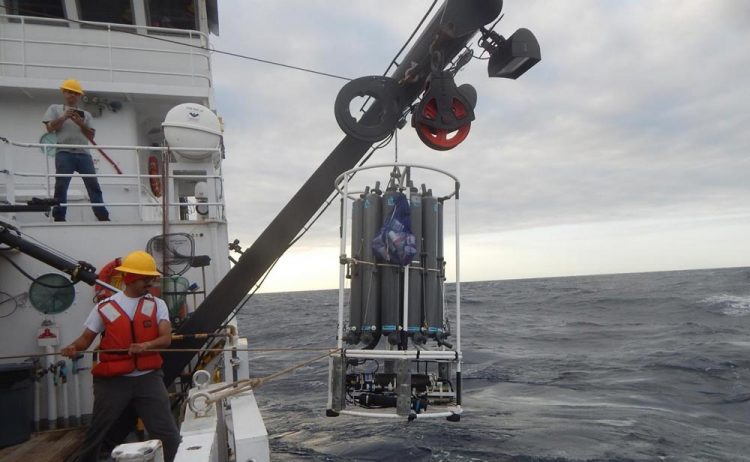Research finds link between rainfall and ocean circulation in past and present

Kaustubh Thirumalai (Brown University) helping retrieve a CTD instrument, which collects water samples and measures physical parameters of oceanic waters such as temperature, aboard the R/V Point Sur in the northern Gulf of Mexico. Credit: Caitlin Reynolds (USGS)
The findings, published on Jan. 26 in Nature Communications, are important because the detailed look into Earth's past climate and the factors that influenced it could help scientists understand how these same factors may influence our climate today and in the future.
“The mechanisms that seem to be driving this correlation [in the past] are the same that are at play in modern data as well,” said lead author Kaustubh Thirumalai, postdoctoral researcher at Brown University who conducted the research while earning his Ph.D. at the UT Austin Jackson School of Geosciences. “The Atlantic Ocean surface circulation, and however that changes, has implications for how the rainfall changes on continents.”
Thirumalai conducted the work at The University of Texas Institute for Geophysics (UTIG), a research unit at the UT Jackson School of Geosciences. Co-authors include UTIG scientists, and researchers from the U.S. Geological Survey St. Petersburg Coastal and Marine Science Center and the Massachusetts Institute of Technology.
The Atlantic Ocean surface circulation is an important part of the Earth's global climate, moving warm water from the tropics towards the poles. The foundation of the research involved tracking the changes in ocean circulation in new detail by studying three sediment cores extracted from the seafloor of the Gulf of Mexico in 2010 during a scientific cruise. The samples give insight into factors that influenced the strength of the ocean current in about 30-year increments over the past 4,400 years.
“If we go back in increments of 30, we're well positioned to understand things on the order of centuries,” Thirumalai said. “And the question we decided to ask was what can those reconstructions of temperature and salinity tell us about the greater Atlantic Ocean surface circulation.”
The small time increments scientists were able to capture in the cores are due to the large amounts of sediment that empty into the Gulf from rivers in Mexico and North America. The scientists extracted data about temperature and salinity data–factors that influence ocean current strength– from ocean-dwelling microorganisms called foraminifera preserved in the sediments.
The data showed that, in comparison to today, the Atlantic Ocean surface circulation was much weaker during the Little Ice Age, a cool period thought to be triggered by volcanic activity that lasted from 1450-1850. Since these set of ocean currents are known to influence global climate, the researchers were interested to see if it correlated with rainfall in the Western Hemisphere, and how such a correlation could change over time.
To calculate the correlation during the Little Ice Age, researchers compared the core data with proxies for precipitation data, such as data from tree rings, cave formations and other natural records. And to calculate the modern correlation, they compared data collected by humans during the last century on the temperature and salinity of the Gulf and rainfall in the Western Hemisphere. They also analyzed data from a climate model developed by the Max-Planck Institute for Meteorology in Germany to predict what the correlation between the current and rainfall would be expected to be during the Little Ice Age.
The results indicate that in present and past the Atlantic Ocean surface currents correlate with rainfall patterns in the Western Hemisphere. Thirumalai said that this finding is important for two reasons. It shows that a correlation exists between the current and rainfall patterns, and that the correlation is evident in data sets that cover different time scales.
“It was remarkable,” Thirumalai said. “These patterns that are based on decadal analysis of modern data, and then the hydroclimate proxies that give the salinity in the oceans and the rainfall on land seem to show the same picture.”
The findings emphasize the importance of the Atlantic Ocean surface circulation to rainfall, and that changes in the current can have far reaching impacts. That means that future changes to the Gulf's salinity and temperature could be expected to influence the climate in other ways.
“The study demonstrates a robust century-scale link between ocean circulation changes in the Atlantic basin and rainfall in the adjacent continents during the past 4,000 years,” said UTIG Director Terry Quinn, a co-author on the study. “And hence it provides a baseline for predictions on how that part of the climate system may behave in the future.”
###
The research was supported by the National Science Foundation, National Oceanic and Atmospheric Administration, the Consortium for Ocean Leadership, the UT Jackson School of Geosciences and Brown University.
Media Contact
All latest news from the category: Earth Sciences
Earth Sciences (also referred to as Geosciences), which deals with basic issues surrounding our planet, plays a vital role in the area of energy and raw materials supply.
Earth Sciences comprises subjects such as geology, geography, geological informatics, paleontology, mineralogy, petrography, crystallography, geophysics, geodesy, glaciology, cartography, photogrammetry, meteorology and seismology, early-warning systems, earthquake research and polar research.
Newest articles

First-of-its-kind study uses remote sensing to monitor plastic debris in rivers and lakes
Remote sensing creates a cost-effective solution to monitoring plastic pollution. A first-of-its-kind study from researchers at the University of Minnesota Twin Cities shows how remote sensing can help monitor and…

Laser-based artificial neuron mimics nerve cell functions at lightning speed
With a processing speed a billion times faster than nature, chip-based laser neuron could help advance AI tasks such as pattern recognition and sequence prediction. Researchers have developed a laser-based…

Optimising the processing of plastic waste
Just one look in the yellow bin reveals a colourful jumble of different types of plastic. However, the purer and more uniform plastic waste is, the easier it is to…



